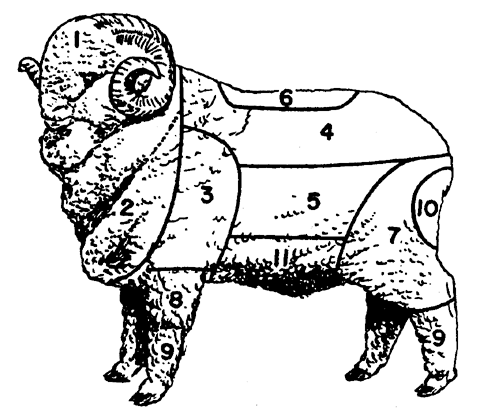
skirting and grading decisions | fleece skirting | table skirting protocol | grading wool | fiber diameter | length of staple | packaging | scouring and cleaning the wool | carding | combing | spinning | weaving and knitting | finishing
Introduction:
There are 11 kinds of wool on one fleece (fine and medium wooled breeds), all differing in value to the end user. According to the American Wool Handbook, no two fleeces, even from the same type of sheep and from the same area, are exactly alike in quality and quantity. Unless fleeces are skirted, graded, and sorted, the final wool product will not be as profitable or as consistent. This drawing shows a fine-wooled Rambouillet or Merino. The numbers identify the various parts on the animal that carry the different sorts possible from one type of wool fleece.
The number and name of the corresponding parts for the drawing are as follows:
Manufacturing Processes:
These are post-shearing activities that can enhance the value of any wool clip; however, unless the people performing these operations are trained and skilled, damage and economic losses can occur.Fleece Skirting: Wool preparation is important in maintaining the quality of the animal fiber clip. This step reflects the attitude of the producer in marketing a useful product to either the industry or individuals. A reputation for a clip is established whether it is on the grading line at a large warehouse, at a processing mill, or being utilized by a home-based business enterprise.
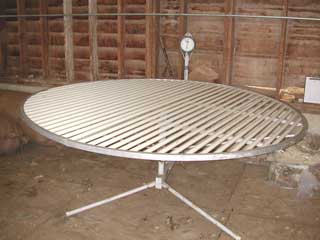
Fleece skirting, in its simplest method, is sometimes referred to as "floor
skirting" and/or "table skirting." Floor skirting is where the belly, head,
and leg wool are removed prior to rolling the fleece loose or tying the
fleece. Table skirting requires the fleece to be removed from the floor and
spread on the skirting table flesh down. A skilled person can remove
the fleece from the floor and flip the fleece on the table with the ease of
shaking out a blanket. A skirting table is usually 5 feet wide and 8-10 feet
in length. Another type of skirting table is one that is circular or round
with a diameter of at least 6 feet or more. One popular method of construction
is using 1 inch plastic pipe spaced 1 inch apart. This permits the
second cuttings, dirt, and vegetable matter to fall through to the floor. An
example of this table is shown above.
Table Skirting Protocol: It is assumed that the belly, head and leg wool was removed on the shearing floor.
Fleece Skirting Sections:
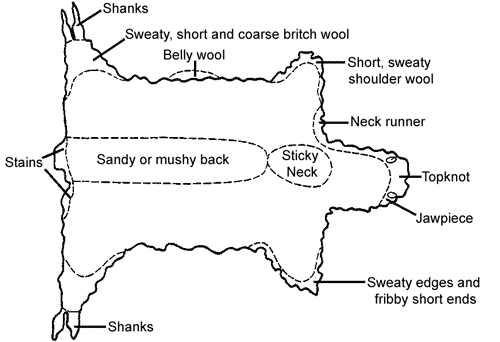
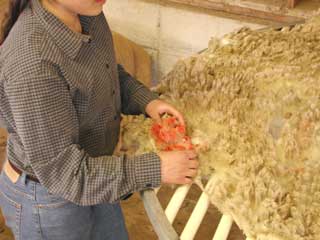 |
|
|
If the video
does not play, you must install an MPEG video |
Traditionally, the
standard method of measuring these fibers is by a microprojection technique in
which short longitudinal sections of the fibers are projected onto a screen at
500-fold magnification. Electro-optical and image analysis machines have the
capability of measuring 2,000 fibers. An average is calculated, along with a
standard deviation and a coefficient of variation. All of this information is
gathered, calculated, and printed with a histogram in less than 3 minutes (see
figure below). Examples of two of these types of machines are discussed in the
following information. The Optical Fiber Diameter Analyzer 100 (OFDA100) analyzes 2 mm snippets of the
original scoured sample. These fibers are spread automatically onto a glass
slide and loaded into the OFDA. The OFDA can measure 4,000 fibers in about 30
seconds. The latest OFDA machine, the OFDA2000, is a portable unit that can
analyze grease wool and diameter profile along the staple. The OFDA2000 allows a
producer to analyze about 800 samples in 8 hours, while never leaving the
shearing pen. Distribution of Fiber Diameter: In general, coarser fibers are stronger and are more resistant to breaking.
Although there are no absolute rules, the following products can generally be
manufactured from fibers with the associated micron diameters:
Grading Wool: In
the United States wool is graded using one of three methods:
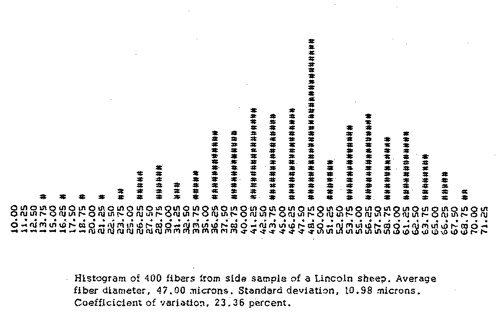
This is a histogram of wool taken from a Lincoln sheep.
The Sirolan-Laserscan uses a scoured, 20 g subsample for fiber diameter
measurement. The sample is carded using a Shirley Analyzer to remove vegetable
matter and blend the fibers in an open web. The web is divided into four
sections and placed into a minicore set above the Laserscan. The snippets fall
into the Laserscan and are mixed automatically into a solution within the
instrument. The Laserscan measures 1,000 fibers from each of the four sections
for a total of 4,000 fibers.
Individual fibers vary in diameter within any fleece. The britch typically is
coarser than the rest of the fleece, even in fine-wool breeds selected for
uniformity. In crossbreeds and sheep of coarser wool breeds, it is common to
find fibers representing 4-5 spinning counts within the same fleece.
It is to the manufacturers’ advantage to know how much grade variation exists
in any given lot of wool before determining its fair market value. The amount
of grade variation is expressed as either the "standard deviation" or
"coefficient of variation." Most micron test reports include this information.
The standard deviation measures the distribution or variation of fiber
diameters around an average. Two-thirds of the fibers’ diameters are within
one standard deviation of the average fiber diameter. Highly variable wool
will have a larger standard deviation.
The American Society for Testing Materials (ASTM) has established variability
limits for wool fineness. If a wool sample is more variable, or has a higher
standard deviation than the one allowed for that grade, the grade is then
lowered one spinning count. The "coefficient of variation" is another useful
measurement of fiber diameter variability. The coefficient of variation is the
fraction or percentage that the standard deviation is of the average. This
statistic is most useful in comparing the variation of unrelated groups, such
as coarse wool variation versus fine wool variation. A standard of uniformity
based on coefficient of variation has been developed for wool and the use of
objective measurements. Obtaining side and britch sample micron tests on
replacement animals, particularly rams, will be more important as the industry
demands higher quality, more uniform wool.
| Micron Range | Product |
| 16 -19 | Fine worsted and intimate wear |
| 19 - 23 | Apparel, outerwear, quilt-batting, felts |
| 23 - 28 | Sweaters, light upholstery coatings, comforters |
| 28 - 32 | Upholstery, tapestries, some carpets |
| 32 - 38+ | Carpets, industrial use |
| A COMPARISON OF THE WOOL GRADES* | |||
| British, Bradford and/or Spinning Count System | American and/or Blood System | Micron System Range for Average Fiber Diameter (Microns) | Maximum Standard Deviation |
| Finer than 80s | Fine | under 17.70 | 3.59 |
| 80s | Fine | 17.70 - 19.14 | 4.09 |
| 70s | Fine | 19.15 - 20.59 | 4.59 |
| 64s | Fine | 20.60 - 22.04 | 5.19 |
| 62s | 1/2 Blood | 22.05 - 23.49 | 5.89 |
| 60s | 1/2 Blood | 23.50 - 24.94 | 6.49 |
| 58s | 3/8 Blood | 24.95 - 26.39 | 7.09 |
| 56s | 3/8 Blood | 26.40 - 27.84 | 7.59 |
| 54s | 1/4 Blood | 27.85 - 29.29 | 8.19 |
| 50s | 1/4 Blood | 29.30 - 30.99 | 8.69 |
| 48s | Low 1/4 Blood | 31.00 - 32.69 | 9.09 |
| 46s | Low 1/4 Blood | 32.70 - 34.39 | 9.59 |
| 44s | Common | 34.40 - 36.19 | 10.09 |
| 40s | Common | 36.20 - 38.09 | 10.69 |
| 36s | Braid | 38.10 - 40.20 | 11.19 |
| Coarser than 36s | Braid | over 40.20 | ---- |
| *According to ASTM Standard Specification D-3991 | |||
Length of Staple:
Twelve months is considered as the natural growth period for the wool
staple. All of its component properties are likely to be developed to the best
possible extent in this amount of time. Different breeds of sheep will have
very different amounts of wool growth during any 12 month period. For example,
the fine Merino breeds may only have a staple length of 1.5 inches in 12
months, while the well fed Navajo-Churros can have a staple length of over 12
inches in that same amount of time.
Cause of Variations in Length of Staple:
Variation in length and fiber diameter is due to quite a number of things.
The following list contains many of the most common:
Length of Staple Affecting the System of Manufacture:
In most cases, length will decide the purpose for which the wool can be
utilized and also the most suitable method of treatment to be adopted. With
fine wool, length often determines whether a wool will be acceptable to the
worsted or woolen system of processing.
The worsted processes utilize the longer or "combing" wools. It generally
produces a higher grade material. The short stapled wools are more profitably
used in the woolen processes. The woolen system produces some high grade
materials from short fine wool, as well as absorbing the very lowest types of
wool. In the woolen manufacturing processes a high grade "cloth" is
manufactured from the short wool (under 2 inches) of good character. Wool of
this type is often referred to as "clothing wool." Using the Noble comb or
Bradford system, sound wools of 2 inches and over are profitably combed,
whereas domestic manufacturers using the Heilmann comb will profitably comb
wool 1.5 to 2 inches long. Crossbred wools of around 7 inches and longer in
length undergo a preparation process before combing or in lieu of combing,
whereas sound wools under that length are carded prior to combing.
Length in Relation to Strength and Evenness in Yarn:
In cloth construction, it must be kept in mind that a stronger yarn is
made from the longer fibers. For this reason, the longer, sound stapled wools
are selected for the manufacture of warp yarn. This yarn has to stand higher
tensions and be more elastic during weaving. (Warp is the foundation element
of a textile that is strung on the loom and held under tension during the
weaving process. Weft is the filler element that is interlaced with the warps
to form the fabric.)
The longer fibered wools that have an even length also give a smoother yarn
when spun on the worsted system. This makes the yarn desirable for worsted
purposes and particularly warp yarns. For the woolen system, on the other
hand, the best and most even yarns are produced with shorter fibers, which are
more readily "drafted" in spinning.
|
Comparison of Wool Grading Systems with Staple Length Classifications |
|||||
| American or Blood System | British, Bradford or Spinning Count System | Combing Staple (inches) | French Combing (inches) | Clothing (inches) | Shrink (%) |
| Fine | 80s, 70s, 64s | 2.5+ | 2.5 - 1.0 | Under 1 | 60 - 67 |
| 1/2 | 62s, 60s | 3.0+ | 3.0 - 1.5 | Under 1.5 | 52 - 62 |
| 3/8 | 58s, 56s | 3.5+ | 3.0 - 2.0 | Under 2.0 | 46 - 54 |
| 1/4 | 54s, 50s | 4.0+ | 4.0 - 3.5 | Under 2.5 | 43 - 48 |
| Low 1/4 | 48s, 46s | 4.5+ | ----- | Under 4.5 | 38 - 43 |
| Common | 44s | 5.0+ | ----- | Under 5.0 | ----- |
| Braid | 40s, 36s | 5.0+ | ----- | Under 5.0 | ----- |
Spinners and Weavers: There is renewed interest in the U.S. in quality,
handcrafted woolen products. Spinners and weavers constitute a specialty
or niche market for certain types of wool, usually bringing premium prices.
The development of fleece shows and sales can be used to encourage spinners to
be present where fleeces are auctioned off. The type of wool desired by this
market include the following: Summary: Although wool and mohair are the least understood of the
American small ruminant industries, it is hoped that the information presented
will enhance the knowledge of the readers and producer. Today, marketing of
lambs and kids is a challenge due to market concentration, but even more
problems exist when marketing the fibers produced by the small ruminants.
Although international markets continue to have a negative impact on the U.S.
wool and mohair producers, niche marketing and value-added activities are
helping to improve the U.S. domestic markets. Producers today are having to
expand their understanding of fiber production and the positive attributes of
their animal fibers. More and more, consumers of wool and mohair products realize that these
natural fibers have unique characteristics that synthetic fibers cannot match.
The end consumer is also demanding better products. This results in more
emphasis being placed on grading and quality evaluation of these raw fibers at
the producer level. Thus, fiber grade or diameter, and fiber class or staple
length must remain part of the producer’s year-round production goals. Finally, it is important to consider that the wool and/or mohair product can
result in as much as 20 percent of the gross annual revenue for a producer. In
order to take advantage of this potential revenue, producers must be aware of
breed differences in fleece and fiber production. The producer must also be
aware of environmental influences that can damage the fleece or fiber and hinder
its growth. Sheep Breeds and Their Wool Characteristics:
Many of the larger producers in the western United States that are selling their
individual clips by objective measurement (micron system) and description are
packaging their wool in square polyethylene “Ausi-packs.” These are hydraulic
packed and can weigh 400-800 lbs.
| Sheep Breeds | Diameter (microns) |
Grease
Fleece Weight (pounds) |
Clean
Fleece Yield (%) |
| Border Leicester | 38 - 30 | 8 - 12 | 60 - 70 |
| Cheviot | 33 - 27 | 5 - 8 | 50 - 65 |
| Columbia | 30 - 23 | 9 - 14 | 45 - 55 |
| Corriedale | 31 - 24 | 9 - 14 | 45 - 55 |
| Debouillet | 23 - 18 | 9 - 14 | 45 - 55 |
| Delaine-Merino | 22 - 17 | 9 - 14 | 40 - 50 |
| Dorset | 33 - 27 | 5 - 8 | 50 - 65 |
| Finnsheep | 31 - 24 | 4 - 8 | 50 - 70 |
| Hampshire | 33 - 25 | 5 - 8 | 50 - 60 |
| Lincoln | 41 - 34 | 10 - 14 | 55 - 70 |
| Montadale | 30 - 25 | 5 - 9 | 45 - 60 |
| Oxford | 34 - 30 | 5 - 8 | 50 - 60 |
| Rambouillet | 23 - 19 | 9 - 14 | 45 - 55 |
| Romney | 39 - 32 | 8 - 12 | 55 - 70 |
| Shropshire | 33 - 25 | 5 - 8 | 50 - 60 |
| Southdown | 29 - 24 | 5 - 8 | 40 - 55 |
| Suffolk | 33 - 26 | 4 - 8 | 50 - 60 |
| Targhee | 25 - 21 | 9 - 14 | 45 - 55 |